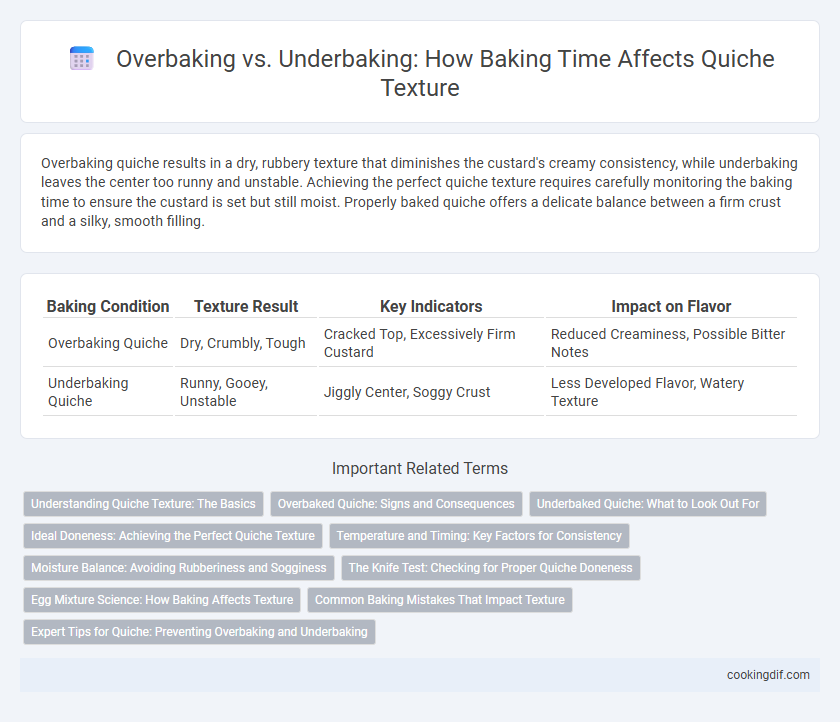Overbaking quiche results in a dry, rubbery texture that diminishes the custard's creamy consistency, while underbaking leaves the center too runny and unstable. Achieving the perfect quiche texture requires carefully monitoring the baking time to ensure the custard is set but still moist. Properly baked quiche offers a delicate balance between a firm crust and a silky, smooth filling.
Table of Comparison
| Baking Condition | Texture Result | Key Indicators | Impact on Flavor |
|---|---|---|---|
| Overbaking Quiche | Dry, Crumbly, Tough | Cracked Top, Excessively Firm Custard | Reduced Creaminess, Possible Bitter Notes |
| Underbaking Quiche | Runny, Gooey, Unstable | Jiggly Center, Soggy Crust | Less Developed Flavor, Watery Texture |
Understanding Quiche Texture: The Basics
Overbaking quiche results in a dry, rubbery texture as the custard curdles and the crust becomes excessively hard. Underbaking leaves the filling too runny and the crust soggy, preventing proper setting and compromising structural integrity. Achieving the perfect quiche texture requires baking until the custard is just set with a slight jiggle in the center and a golden, flaky crust.
Overbaked Quiche: Signs and Consequences
Overbaked quiche often presents a dry, crumbly texture with a rubbery, tough crust due to excessive moisture loss during baking. The custard filling becomes dense and grainy, losing its smooth, creamy consistency essential for an ideal quiche experience. Recognizing signs such as a cracked surface or excessive browning helps prevent compromised flavor and texture balance in quiche preparation.
Underbaked Quiche: What to Look Out For
An underbaked quiche often has a soggy, custard-like center that lacks firmness and may jiggle excessively when gently shaken. Symptoms include a pale, wet appearance on top and a crust that fails to crisp or brown adequately. To avoid disappointing texture, cautiously check doneness by inserting a knife or toothpick into the center to see if it comes out with minimal liquid custard attached.
Ideal Doneness: Achieving the Perfect Quiche Texture
Achieving the perfect quiche texture requires precise baking time to avoid overbaking, which results in a dry, crumbly custard and a tough crust, or underbaking, causing a soggy center with a runny consistency. Ideal doneness is indicated by a slightly jiggly center that firms up as it cools, ensuring a creamy yet fully set custard and a tender, flaky crust. Monitoring internal temperature around 165degF (74degC) helps maintain optimal moisture balance and texture for a flawless quiche.
Temperature and Timing: Key Factors for Consistency
Proper temperature and timing are crucial for achieving the ideal quiche texture, as overbaking at high heat results in a dry, rubbery custard, while underbaking leads to a runny, unset filling. Baking quiche at 325-350degF for 35-45 minutes ensures the custard sets evenly without curdling, preserving a creamy and smooth consistency. Monitoring the center's slight jiggle during baking helps balance doneness, preventing overcooked edges and undercooked centers for a perfect texture.
Moisture Balance: Avoiding Rubberiness and Sogginess
Achieving the perfect quiche texture depends on balancing moisture to prevent rubberiness or sogginess. Overbaking evaporates too much moisture, causing the filling to become rubbery and dry, while underbaking leaves excess moisture, resulting in a soggy, unset custard. Monitoring baking time and using a precise oven temperature around 350degF (175degC) ensures a creamy, smooth filling with a tender crust.
The Knife Test: Checking for Proper Quiche Doneness
The knife test is essential for determining the perfect quiche texture, signaling whether it is overbaked or underbaked. Inserting a clean knife into the center should come out mostly clean with moist crumbs, indicating a creamy, custard-like consistency without being runny or dry. Overbaking causes a tough, rubbery texture and cracked surface, while underbaking results in a soggy, unset filling.
Egg Mixture Science: How Baking Affects Texture
Overbaking a quiche causes the egg proteins to over-coagulate, resulting in a dry, rubbery texture as the moisture is driven out. Underbaking leaves the egg mixture slightly runny and unset, preventing the custard from achieving its creamy consistency due to incomplete protein coagulation. Achieving optimal texture hinges on precise heat application to allow proteins to solidify just enough for a smooth, tender custard without curdling.
Common Baking Mistakes That Impact Texture
Overbaking quiche causes the custard to become dry and rubbery, while underbaking results in a runny, unset filling that compromises texture and flavor. Common baking mistakes include inaccurate oven temperature and uneven heat distribution, which can lead to inconsistent doneness and affect the smooth, creamy texture expected in a perfect quiche. Proper baking time and temperature are crucial for achieving a tender crust and a silky, fully set custard.
Expert Tips for Quiche: Preventing Overbaking and Underbaking
Expert tips for quiche emphasize achieving the perfect balance to avoid overbaking, which results in a dry, rubbery texture, and underbaking, which causes a runny, under-cooked center. Baking quiche at a moderate temperature, such as 350degF (175degC), and monitoring the custard's firmness ensures a creamy, smooth texture without cracking. Using a water bath during baking can also help regulate heat distribution, preventing uneven cooking and maintaining optimal moisture.
overbaking vs underbaking for quiche texture Infographic

 cookingdif.com
cookingdif.com